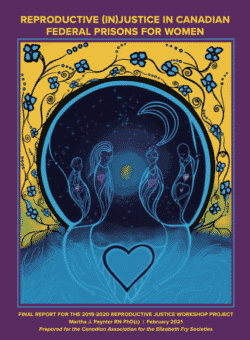Post #165. This post is 930 words, 5 minutes to read.
By Victoria Carmichael, JD Candidate at Queen’s Law.
Approximately 676 women are incarcerated in federal prisons on an average day (Public Safety Canada, 2019). Yet, there is little to no research examining their reproductive health. The Correctional Service Canada (CSC) is responsible for the delivery of health services in federal prisons but has never published a report on the reproductive health of federally incarcerated women.
A recent report by Martha Paynter, published by the Canadian Association for the Elizabeth Fry Societies (CAEFS), describes how federal incarceration hampers reproductive justice by restricting access to health services, restricting the reproductive potential of certain populations, and destroying family connections. In particular, the report touched on the lack of cancer screenings, sanitary products, a nd an increase in peripartum depression. These factors most significantly affect Indigenous women as they are overrepresented in federal prisons.
nd an increase in peripartum depression. These factors most significantly affect Indigenous women as they are overrepresented in federal prisons.
The report is based on Reproductive Justice workshops done by Elizabeth Fry societies that – through education about reproductive health and reproductive justice – sought to empower incarcerated women to bring forward their concerns to CAEFS advocates.
What is Reproductive Health and Justice?
The authors clarify that reproductive health not only encompasses physical health, but also mental and emotional wellbeing, social aspects of reproduction, access to health services, including experiences across the lifespan and across all genders. As defined by the World Health Organization:
“Reproductive health is a state of complete physical, mental and social well‐being and not merely the absence of disease or infirmity, in all matters relating to the reproductive system and to its functions and processes. Reproductive health, therefore, implies that people are able to have a satisfying and safe sex life and that they have the capability to reproduce and the freedom to decide if, when and how often to do so.”
The term Reproductive Justice was invented in 1994. The developers, Black American feminists who called themselves the Women of African Descent for Reproductive Justice, critiqued the right to abortion as the focus of feminist activism. They believed that reproductive justice was not just about abortion, but that, in particular, women of colour and other marginalized women have difficulty accessing contraception, comprehensive sex education, STI prevention and care, alternative birth options, adequate prenatal and pregnancy care, domestic violence assistance, adequate wages to support our families, safe homes, and so much more.
Reproductive Justice expands concepts of reproductive rights to include the right to self-governance over one’s body, to not have children, to choose to have children and to parent those children in safe and sustainable communities.
Reproductive Health and Justice in Prison
The participants in the CAEFS workshops shared the many aspects of prison life that impede their access to reproductive health and justice. For instance, “women who are incarcerated in Ontario are more likely to be overdue for cervical cancer screening than the general population, with 53% of imprisoned women overdue”. The authors found no data on breast cancer screening measures in “any level or type of carceral facility in prisons”. This lack of testing exists despite data that concludes “prisoners have increased risk of cancer compared with the general population, with the most common new cancer diagnoses among women prisoners being breast, lung and cervical.”
Issues arise regarding menstruation as well. “A few older participants described menopause as an overlooked area of reproductive health, the symptoms of which make incarceration more difficult.” For other participants, access to sanitary products is an issue – although menstrual hygiene supplies are provided, some participants highlighted that these supplies were restricted, and it was “degrading to have to ask for more”:
“Why don’t they bring a box? You ask for tampons and they bring you three. We don’t want to ask the male staff for tampons.”
Women who are incarcerated are also at higher risk for peripartum depression, the most common complication of pregnancy. A prior mental illness is the “strongest risk factor for peripartum depression” and because “[f]orty-six percent of federally incarcerated women are prescribed psychotropic medication women who experience incarceration are at elevated risk.”
Indigenous Populations
These factors most significantly affect Indigenous women, who are disproportionately overrepresented in the criminal justice system. “Indigenous women make up 42% of federally incarcerated women” in stark contrast to comprising only 4.9% of the general population. As one participant shared, “you could say prisons are the new Residential School.”
The workshops expose the incompatibility of reproductive justice with the over-incarceration of Indigenous women in Canada and the separation of all incarcerated mothers from their children. For Indigenous women, “prison is another form of institutional reproductive oppression,” frustrating their ability to parent their own children. Almost all incarcerated parents are separated from their children, akin to the experiences felt with residential schools. Although only 7.7% of children in Canada are Indigenous, according to the report Indigenous children represent 52.5% of those removed from their families by the state. A significant percentage of those incarcerated were themselves in foster care in their youth, which the authors identify as “demonstrating the intergenerational impact of criminalization and its impact on reproductive justice.”
As the authors recognize, there is still progress to be made with respect to understanding incarcerated people’s reproductive health experiences, knowledge, and needs. But even a preliminary understanding of the needs of incarcerated women can help improve the provision of health care services in federal prisons.
“We envision a future where people are sovereign over their bodies, sovereign over their decisions to shape their families and live with their children in safe and sustainable communities. As one participant said, ‘We need to be beating the drum louder.’
Read the full report here.
Back

Comments are closed here.